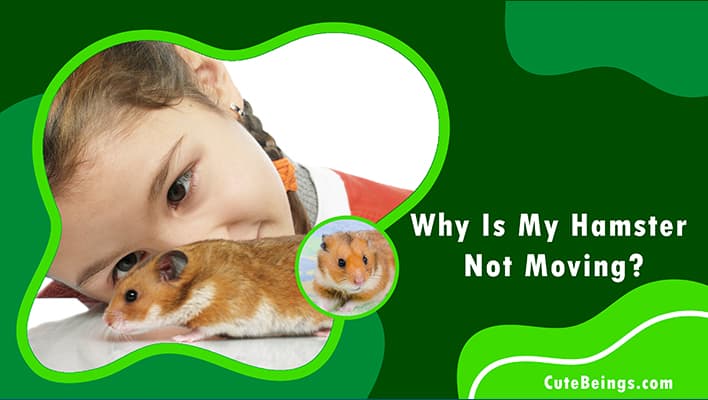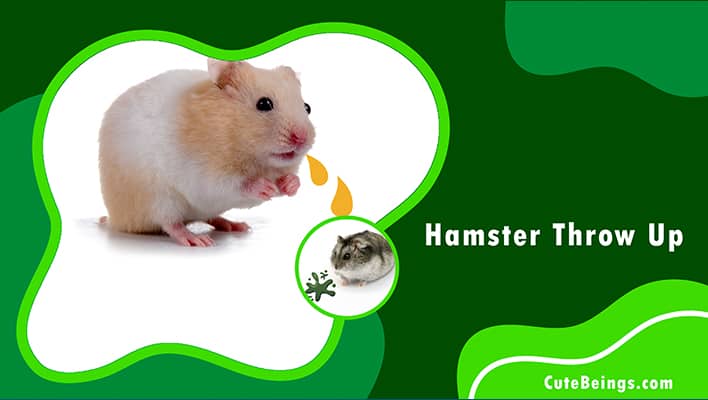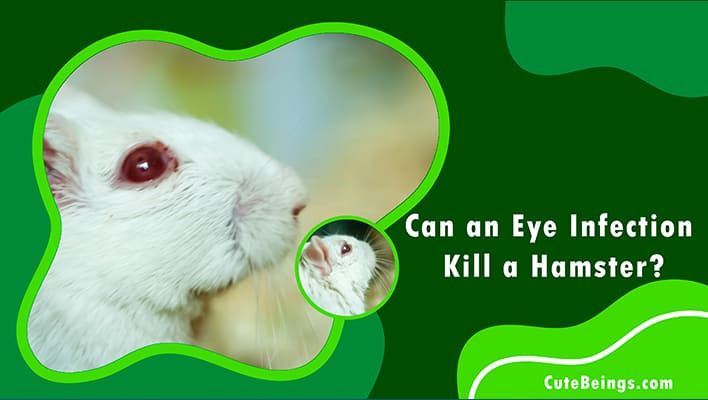Hamsters are sensitive and close-knit, which quickly makes them experience grief. Perhaps they are severely ill, or maybe they’re just missing their owner in the long, gloomy winter. Unwillingly, sad hamsters go through the routines of a boring lifestyle. As a result, they exhibit various symptoms of depression from time to time.
A sad hamster appears to exhibit a variety of strange behaviors and habits even to those who are familiar with it. They too experience boredom, sadness, and loneliness during their day. so it is important to spot problems at home by paying attention and making a few minor adjustments to their regular work patterns.
Table of Contents
Signs Of A Sad Hamster
Biting and scratching the cage
When a hamster is sad, it exhibits strange actions, such as gnawing at its cage repeatedly with its set of long teeth. They usually start biting things once their teeth start to grow in, but this is not always the case. When they are in pain, you might see some unfamiliar weird patterns. If the bars are missing paint, scratched, or bent out, it’s time to pay closer attention to them. Biting results in oral injuries and tooth fractures. Consequently, the larger the cage, the more happy your hamster will be.
Make unpleasant noises
Hamsters are generally quiet creatures, as long as they are not in a state of distress. Whenever they are uncomfortable or stressed, it begins to generate a variety of noises like hissing, crying, or screaming to alert the owner. Sad hamsters make high-pitched squeaking sounds due to injuries or shocks. These vocalizations are not so pleasant to hear, anyhow will help to let you know their present condition accurately. Instead, some rub their teeth against each other, creating a clicking sound, which is typically an indication of a happy and content hamster.
Posses Lethargic conducts
A sad hamster is idle and lethargic. It is inactive all of the time and sleeps for longer periods. They don’t react to your reactions and won’t come out of the cage at times, either. Poor eating habits and a lack of appetite are possible side effects. Hamsters that are old, ill, or who are lonely often have a sluggish or dull mood. A happy hamster is always vibrant and eager to get the attention of others.
Climbing the cage
It is better to know that often climbing, hanging, or sticking one’s head out of the cage is an indication that one’s hamster isn’t feeling well. It could be because they’ve been confined to tiny rooms and forced into mundane lifestyles. They might expect a change in day-to-day habits or to spend more time playing.
A newcomer or baby hamster, generally known as a pup, may display a variety of behaviors inside the cage, which you need not worry about. Some of the creatures even make it a practice to climb the cage, and they seem to like it. Anyhow, the caretaker should be more watchful of the irregular anomalous actions.
Aggressive behaviors
A hamster’s aggression is a clear sign that it is unhappy. When you try to touch them, some may bite your hand, try to run out, or make hissing noises that frighten or annoy you. Also, it will exhibit hostile postures like laying on his back and baring his teeth, by making violent disciplines impossible to deal with, that are not typical.
A piece of fresh fruit or vegetable on hand and a gentle shifting are preferable when such rapid changes are observed. Do not yell or beat them. End up creating a relationship of trust with it and giving it the freedom it needs to feel better.
Decreased appetite
If your hamster is refusing to eat even its favorite foods such as strawberries, apples, pears, or bananas, it is critical to tackle this issue. Sad hamsters have poor eating habits, which have a direct effect on their growth and hygiene. Skin irritation, vomiting, and weight loss could occur as a result of a lack of food intake.
These animals are nocturnal, meaning they are most alert and active at night. As a result, some may feed at midnight. Keep a close eye on their behavioral patterns and responses to food or water. In case you are not satisfied, you should seek medical attention from a veterinarian.
Hiding and burrowing
If your little one is unhappy, they tend to hide in order to get away from the people around them. Toys aren’t what they want. They don’t want to be the focus of attention. They will refuse food or dismiss daily activities.
This is a common burrowing habit that hamsters engage in to hide in play structures or tunnels. Newcomers might not be familiar to owners. A set of altered or unexpected behaviors might be due to a different reason. They may be attempting to tell you how awful they’re feeling.
Lays down carelessly in random places
Sad hamsters are too lazy to do their job well enough. They start to sleep too much outside of their cage on bad days. Though they are afraid and prefer to stay in safe places, they start to come outside and lie on the edges of the floor or under your chair. Some of them will go to the corners of their cages when they are mentally hurt.
This is never a good sign because it indicates that their life is in danger. They may be attacked by other animals, experience dizziness or any other illness without the owner’s notice, or it may be difficult to locate the site because they choose random areas to lay down when they are sick.
Making escape plans or being inactive at night
A sad hamster attempts to escape from its cage or territory area. This is never a positive move. It may get lost, become subject to predators, or become ill as a result of mental instability. The owner, on the other hand, will become upset or scared. Some may choose to sleep through the night and remain dormant during the day. The problem may be caused by the smaller cages and playful habits of these young rodents, but if the problem persists, it is almost certainly related to a mental disorder that requires your support.
Recurring behaviors
It is confusing to observe recurring behaviors in your hamster like moving their bedding to the same place over and over again or excessive grooming. Regular grooming practices prove the healthy nature and happiness of your pet, but in some instances, over-grooming or constant face washing are signs of a sad mood. Besides old aged or sickened ones normally neglect to groom themselves. It is confusing to observe recurring behaviors in your hamster like moving their bedding to the same place or grooming too much.
Regular self-grooming practices prove the healthy nature and happiness of your pet. But in some instances, over-grooming or constant face washing are signs of a sad mood. Besides old aged ones or sickened ones normally neglect to groom themselves.
Pacing is done usually when anybody is worried or nervous. Sad hamsters too follow such simple but exceptional behaviors. Some tend to carry the toys back and forth or store food either inside chubby cheeks or in everyday locations without eating.
To provide better care, monitor your hamster’s daily behaviors and assure its health and safety to keep it happy and lovable at all times.
Tactics to Mood-Fixing in Sad Hamsters
Owners should be aware of techniques to cheer up one’s beloved pets to help them overcome their despair and tough days by providing better care.
Ensure good diet plans with enough water and fresh edibles; fruits, vegetables, lettuce, grains, seeds, or nuts.
They need to chew a lot to help them digest and avoid some illnesses. They also fill their cheeks with food or store things in their safest place. People should not mess with these processes because it will make them unhappy and lose their trust and happiness.
Daily affection
It is the best remedy to console a sad hamster. Why? Because if you play with them for at least one hour a day and get to touch them or play with their favorite toys (wooden pet chew toys), you will show more caring and the hamster will be delighted.
Make sure the cage is clean
It is essential to keep the area surrounding neat and tidy. When choosing a cage, larger ones are always better. The recommended minimum size is 24 inches by 12 inches and at least 12 inches tall. This can lessen the hamster’s tension and discomfort. Remember to place their home in a quiet and safe environment.
Allow Sand baths
Hamsters get cleaned up by themselves. But a 15- to 20-minute sand bath once a week does no harm. As they are in cages for a long period, allow them to enjoy these natural methods too. Remove the sand immediately after use to avoid skin irritations and breathing problems. Besides, some creatures tend to sleep there for a while, so refrain from using dust.
Consult a veterinarian
If none of the above work, get your little one medical attention right away. A physical deficiency may be the cause. Sad hamsters tend to hide their emotions, making others harder to figure out. It’s never a good idea to treat your ill pet using human household cures. Inappropriate treatments or overdose may harm them. So take it to a vet and acquire the necessary medicines while maintaining a safe and sound atmosphere for them to relax.
It’s adorable to adopt a hamster as a pet! Meanwhile, be more careful with their growth and emotions at all times to ensure a happy-joyful living.

Hello, my name is James and I’ve been caring for tiny pets for over 14 years with a passion. I enjoy passing on my expertise to other individuals in order for them to have the same amount of enjoyment as I do.




